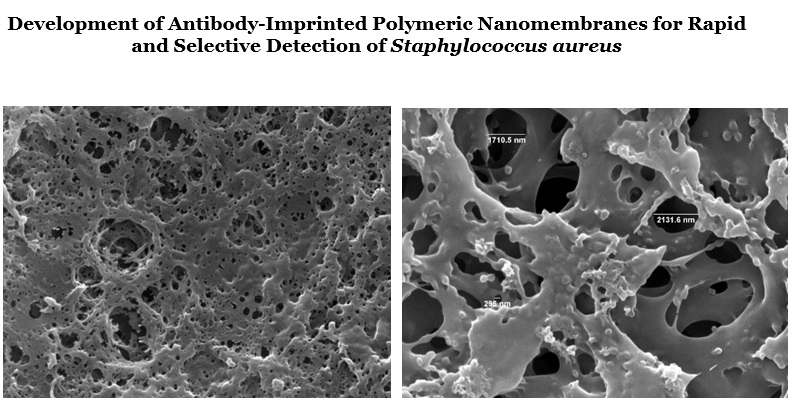Development of Antibody-Imprinted PolymericNanomembranes for Rapid and Selective Detection ofStaphylococcus aureus
Nanomembranes for Rapid and Selective Detection of S. aureus
Keywords:
Staphylococcus aureus detection, , Molecularly Imprinted Polymer, Nanomembranes, Antibodyimprinted polymers, Selective bacterial capture, Food safety, Clinical diagnosticAbstract
Identification and isolation of Staphylococcus aureus is of great importance in clinical and food applications, but traditional methods face several drawbacks. Our current investigation focused on developing and evaluating Molecularly Imprinted Polymer (MIP)-functionalized nanomembranes for selective S. aureus capture. MIPs were synthesized on cellulose acetate membranes via UVinitiated polymerization. Characterization via FTIR confirmed antibody integration, while SEM revealed distinct MIP nanoparticles (20-45 nm) compared to larger non-imprinted polymer (NIP) particles (295-2132 nm). Filtration experiments using S. aureus suspensions (10⁴-10⁵ CFU/mL) demonstrated the membranes' capture capability; notably, filter M3 reduced a 3 × 10⁵ CFU/mL challenge concentration to 4.3 × 10⁴ CFU/mL in the filtrate. Performance varied across formulations, with differences in filtration times and retention efficiencies observed between MIP and NIP filters. To enhance consistency, further optimization of monomer-to-template ratios is recommended. The MIP filters exhibited robust stability over a two-month evaluation period. These findings highlight the potential of antibody-imprinted MIP nanomembranes as promising tools for S. aureus capture, offering a rapid and selective alternative approach that warrants further optimization and testing in complex matrices for practical applications.
Downloads
References
References
1. Rubab M, Shahbaz HM, Olaimat AN, Oh D-H. Biosensors for rapid and sensitive detection of Staphylococcus aureus in food. Biosensors and Bioelectronics. 2018;105:49-57.
2. Chang Y-C, Yang C-Y, Sun R-L, Cheng Y-F, Kao W-C, Yang P-C. Rapid single cell detection of Staphylococcus aureus by aptamer-conjugated gold nanoparticles. Scientific reports. 2013;3(1):1863.
3. Suaifan GA, Alhogail S, Zourob M. Rapid and low-cost biosensor for the detection of Staphylococcus aureus. Biosensors and Bioelectronics. 2017;90:230-7.
4. Xu X, Lin X, Wang L, Ma Y, Sun T, Bian X. A novel dual bacteria-imprinted polymer sensor for highly selective and rapid detection of pathogenic bacteria. Biosensors. 2023;13(9):868.
5. Zhang J, Wang Y, Lu X. Molecular imprinting technology for sensing foodborne pathogenic bacteria. Analytical and bioanalytical chemistry. 2021;413(18):4581-98.
6. Wang R, Wang L, Yan J, Luan D, Wu J, Bian X. Rapid, sensitive and label-free detection of pathogenic bacteria using a bacteria-imprinted conducting polymer film-based electrochemical sensor. Talanta. 2021;226:122135.
7. Allender CJ, Richardson C, Woodhouse B, Heard CM, Brain KR. Pharmaceutical applications for molecularly imprinted polymers. International journal of pharmaceutics. 2000;195(1-2):39-43.
8. BelBruno JJ. Molecularly imprinted polymers. Chemical reviews. 2018;119(1):94-119.
9. Agar M, Laabei M, Leese HS, Estrela P. Multi-Template Molecularly Imprinted Polymeric Electrochemical Biosensors. Chemosensors. 2025;13(1):11.
10. Vahid S, Ahari H, Adergani BA, Reihani SFS. Designing a molecularly imprinted polymer-based nanomembrane for the selective removal of Staphylococcus aureus from aqueous media. Applied Food Biotechnology. 2021;8(4):275-84.
11. Elhabal SF, Abdelmonem R, El Nashar RM, Elrefai MFM, Hamdan AME, Safwat NA, et al. Enhanced antibacterial activity of clindamycin using molecularly imprinted polymer nanoparticles loaded with polyurethane nanofibrous scaffolds for the treatment of acne vulgaris. Pharmaceutics. 2024;16(7):947.
12. Doostmohammadi A, Youssef K, Akhtarian S, Tabesh E, Kraft G, Brar SK, et al. Molecularly imprinted polymer (MIP) based core-shell microspheres for bacteria isolation. Polymer. 2022;251:124917.
13. Chen M, Lu J, Gao J, Yu C, Xing W, Dai J, et al. Design of self-cleaning molecularly imprinted membrane with antibacterial ability for high-selectively separation of ribavirin. Journal of Membrane Science. 2022;642:119994.
14. Whyte HE, Montigaud Y, Audoux E, Verhoeven P, Prier A, Leclerc L, et al. Comparison of bacterial filtration efficiency vs. particle filtration efficiency to assess the performance of non-medical face masks. Scientific Reports. 2022;12(1):1188.
15. Tse Sum Bui B, Auroy T, Haupt K. Fighting Antibiotic‐Resistant Bacteria: Promising Strategies Orchestrated by Molecularly Imprinted Polymers. Angewandte Chemie International Edition. 2022;61(8):e202106493.
16. Idil N, Mattiasson B. Imprinting of microorganisms for biosensor applications. Sensors. 2017;17(4):708.
17. Gkika DA, Tolkou AK, Lambropoulou DA, Bikiaris DN, Kokkinos P, Kalavrouziotis IK, et al. Application of molecularly imprinted polymers (MIPs) as environmental separation tools. RSC Applied Polymers. 2024;2(2):127-48.
18. Liedtke C, Bienge K, Wiesen K, Teubler J, Greiff K, Lettenmeier M, et al. Resource use in the production and consumption system—The MIPS approach. Resources. 2014;3(3):544-74.
19. Li G, Row KH. Recent applications of molecularly imprinted polymers (MIPs) on micro-extraction techniques. Separation & Purification Reviews. 2018;47(1):1-18.

Downloads
Published
Submitted
Revised
Accepted
Issue
Section
License
Copyright (c) 2025 Sogand Heydari (Author); Hamed Hamed Ahari; Seyed Amirali Anvar, Artemiss Mojalal, Sima Moradi (Author)

This work is licensed under a Creative Commons Attribution-NonCommercial 4.0 International License.